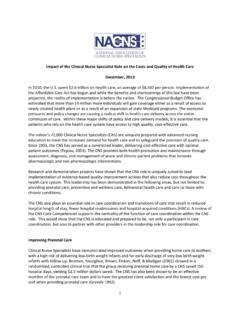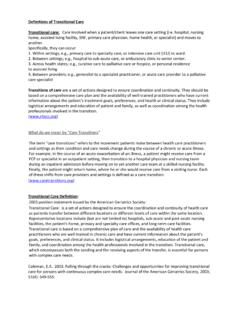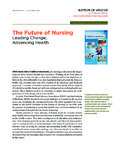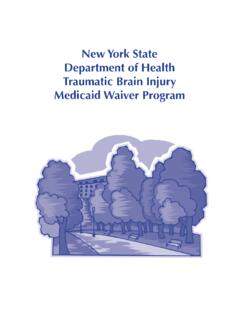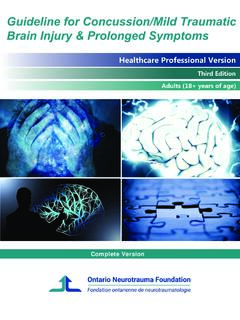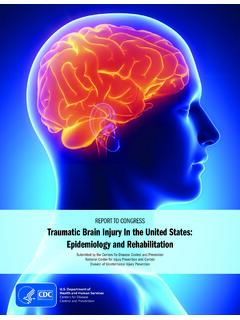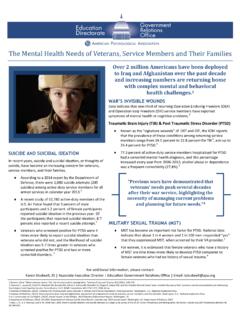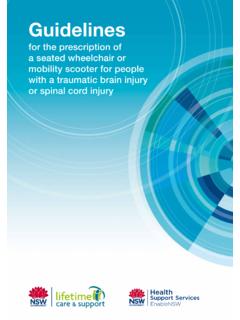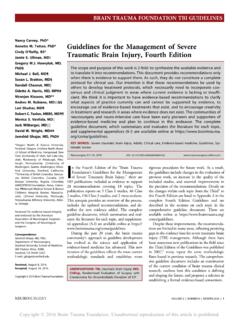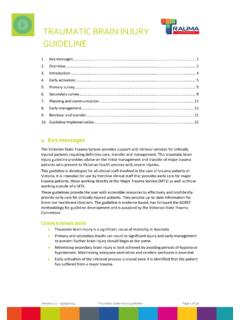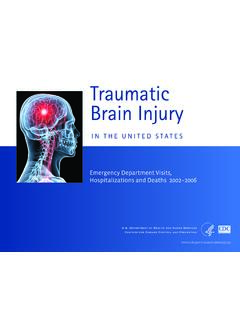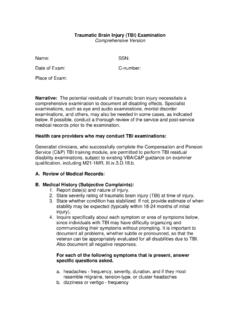Transcription of Managing Neurostorming in a Patient with Severe Brain Injury
1 2/20/2017. Managing Neurostorming in a Patient with Severe Brain Injury MANAGEMENT, TREATMENT OR SO WE THINK! JULIE M. LINDER, MSN, RN, CNS, ACCNS-AG, CCRN. 1. 2/20/2017. Who is at risk? Symptoms Treatment Nursing Interventions Family Interventions Case Study 2. 2/20/2017. Many Names-1 Lived Experience Sympathetic Storm Paroxysmal Sympathetic Hyperactivity (PSH). Autonomic Dysfunction Syndrome Acute Midbrain Disorder Autonomic Storms Storming Neurostorming Dysautonomia Who is at risk? Who is at risk? - Men - 65 or older - 0-4 years of age 3. 2/20/2017. Who is at risk? 65 or older . Who is at risk?
2 65 or older . Fall Who is at risk? Age 5-24 . 4. 2/20/2017. Who is at risk? Age 5-24 . MVC. Who is at risk? Age 0-4 . Who is at risk? Age 0-4 . Assault 5. 2/20/2017. What's the Big Deal?[1]. million ED visits annually Over the past decade TBI ED visits increased by 70%, hospitalization rates increased by 11%, death rates decreased by 7%. 40% of TBI's occur from falls Major public health concern=50K deaths per yr in US. Trauma is leading cause of death for people 45 yr and up 80-90k ppl/yr with long term disability 5 million ppl living with disability from TBI=$ billion/yr How does it Happen?
3 Incidence of Neurostorming [2]. Estimated that 15-33% of patients with a traumatic Injury experience this phenomenon Higher incidence of Neurostorming with Diffuse Axonal Injury 6. 2/20/2017. Pathophysiology Sympathetic vs. Parasympathetic Pathophysiology Sympathetic Parasympathetic Increased HR=increased CO Decreased HR=decreased CO. Bronchial dilation Bronchial constriction Muscular contraction Muscle relaxation Pupillary dilatation Pupillary constriction Decreased UO, sphincter Increased UO, sphincter relaxation contraction Increased GI motility Decreased GI motility Increased glycogen conversion Adrenal release of Epi & Norepi Other Conditions.
4 Intracerebral Hemorrhage Subarachnoid Hemorrhage Brain Tumor Hypoxic Brain Injury Hydrocephalus 7. 2/20/2017. Concurrent Symptoms Hyperthermia Concurrent Symptoms Posturing Concurrent Symptoms Pupillary dilation 8. 2/20/2017. Concurrent Symptoms Concurrent Symptoms Tachycardia . Concurrent Symptoms Tachypnea 9. 2/20/2017. Concurrent Symptoms Diaphoresis Concurrent Symptoms Agitation Concurrent Symptoms Hypertension 10. 2/20/2017. Diagnosis Differential Diagnosis Infection Neuroleptic Malignant Syndrome Malignant Hyperthermia Pulmonary Embolism Autonomic Dysreflexia Central Fever Poor sedation/pain management Withdraw 11.
5 2/20/2017. Differential Diagnosis Infection Hyperthermia Tachycardia Tachypnea HYPOTENSION (sepsis). Pharmacology 1. Pain management 2. Sedation 3. Sympathetic blockade Pain Management Probable drip initially Scheduled- Ex. 5 or 10mg Roxicodone q 4 hours PRN- for break through storms. Ex. Morphine 4mg q 4 hours 12. 2/20/2017. Sedation Probable drip initially PRN- for break through storms. Ex. Versed 4mg q 4 hours Sympathetic Blockade Propanolol 10mg TID. Max dose 320mg/day IR. If contraindicated: Clonidine TID. Max dose Inadequate Control Consider . Increasing propranolol 1st Tier- Precedex (titrate to effect).
6 2nd Tier- Bromocriptine 3rd Tier- Dantrolene 13. 2/20/2017. Precedex Start at mcg/kg/min Max dose mcg/kg/min Caution: Bradycardia Volume Typically only seen in ICU. Bromocriptine Used for pyrexia or diaphoresis Start at to mg daily Max dose 100mg Dantrolene Used for dystonia or posturing Start 25mg/day Max dose 400mg/day Caution Hepatotoxic 14. 2/20/2017. Once you feel like you have control . Transition Precedex to Cloinidine Remove Bromocriptine when pyrexia/diaphoresis resolve Remove Dantrolene when dystonia/posturing resolve Continue Propanolol &. Roxicodone until GCS has stabilized Nursing Interventions -ID of symptoms -Medication management -ID triggers -Calm/quite environment -Reassurance -Family Teaching 15.
7 2/20/2017. 16. 2/20/2017. Family Behaviors Exhausted Overwhelmed Fearful of loss of loved one Scared Hypervigilent Passive Distressed by symptoms Beginning to realize that life has changed Case Study At 1001 the following pt arrives to the trauma bay: Report: 35 year old male presented as a trauma red from OSH. Rollover MVC with loss of consciousness and ejection at the scene. GCS 3 at OSH, intubated. On Diprivan drip. Case Study Primary survey: Airway: Intubated, 26cm at lip Breathing: Equal bilaterally Circulation: 2+ femoral & carotid pulses Disability: GCS 3, pupils L 2mm & sluggish, R4mm & non-reactive Exposure: minor abrasions on bilateral shins & L dorsal hand, no active bleeding 17.
8 2/20/2017. Case Study Vital Signs: RR- 19. Temp- BP- 147/80. HR- 60. Case Study Secondary survey: HENNT- L hemotympanum, midface unstable, cervical collar CV- S1S2, clear breath sounds bilaterally, no crepitus Abd- soft, nondistended Pelvis- stable, Foley in place Perineum: clear, no blood in rectum Back: no stepoffs, no deformity Extremities: mechanically stable, +pulse in all extremities Case Study Evaluation Adjuncts: CXR- high position of EET, advancement recommended. No focal acute cardiopulmonary abnormality. 18. 2/20/2017. Case Study Evaluation Adjuncts: CT head w/o contrast @0531: 1.
9 Stable frontal & left temporal lobe hemorrhagic contusions, large dorsal midbrain contusion. Scattered subarachnoid hemorrhage has mildly progressed. Findings consistent with shear Injury /diffuse axonal Injury . 2. Intraventricular hemorrhage, mildly decreased. Stable nonenlarged ventricular system. The basal cisterns remain patent. 3. Left orbital floor fracture with mild depression; no muscle entrapment. Extensive left periorbital soft tissue swelling and hemorrhage with left exophthalmos and extensive intraconal hemorrhage. Case Study Evaluation Adjuncts: CT spine @ 0532: No acute cervical spinal pathology.
10 Zygomatic arch fracture with dislocation from the right sphenoid bone. Case Study Evaluation Adjuncts: CT Abd/pelvis & Chest @ 0538: 1. Limited examination in the absence of IV contrast. 2. Acute fractures of the left L1 and L2 transverse processes. 3. Debris in the proximal trachea. 4. Possible small amount of pelvic fluid. 5. Small left apical contusions. 19. 2/20/2017. Case Study Evaluation Adjuncts: CT head @ 0934: 1. Stable bilateral frontal and left temporal lobe hemorrhagic contusions;. large dorsal left midbrain hemorrhage. Scattered subarachnoid hemorrhage has mildly progressed. Findings are consistent with shear Injury /diffuse axonal Injury .
